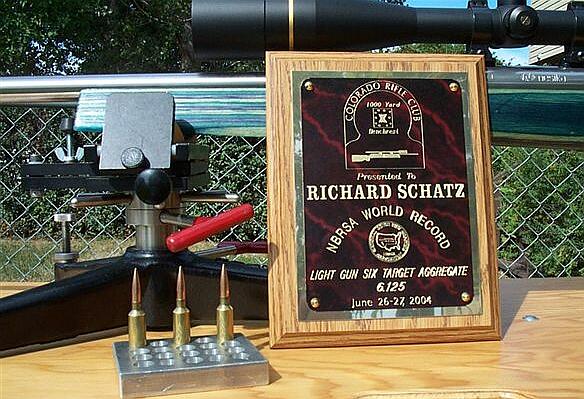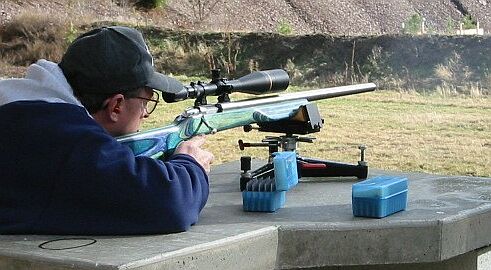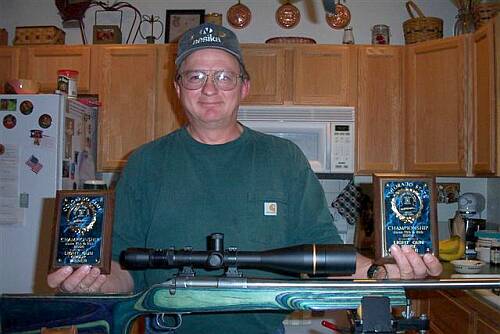 "Records fall when preparation meets opportunity" -- Richard Schatz
"Records fall when preparation meets opportunity" -- Richard SchatzOn June 26-27, in Byers, Colorado, Richard Schatz steered his diminutive 11-pound 6mm Dasher to a new 6-target NBRSA 1000-yard Light Gun World Record. His 6.125" aggregate eclipsed (by 3/4") the previous record set by Tim North (Broughton Rifle Barrels) in September 2003, also in Byers.
Remarkably, Richard set the record with a gun that was a full six pounds under Light Gun limits, the same gun he uses for short- and medium-range Varmint Hunters' Assocation (VHA) competition. In capturing the record (and also setting both Light Gun and Heavy Gun small groups for match), Richard did more than just whittle a few tenths off a record. No, his performance was so dominant you can say he produced some "shock and awe" among his big-caliber competitors.
More Than One Way to Skin a Cat (or Break a Record)Richard's gun and his shooting style defied conventional long-range wisdom in almost every way. The long-range gurus say you need a big 30-caliber bullet (or at least a 6.5) to "Agg" well at 1000. They say you need to build a gun to max weight and grip it when you shoot. They also say you need a heavy, specialized 1000-yard stock with a long fore-end and virtually no drop in the underside of the buttstock. And even the 6 Dasher crowd would say that to compete at 1000 yards, you should use a 28"-30" heavy contour barrel, neck-turned cases, and Varget powder. Well, Richard broke the World Record with a compact Shehane Baby Tracker stock, unturned cases, Reloader 15 powder, and a 26" Rem Varmint contour barrel with 1500+ rounds on it.
Read on, but be prepared to rethink much of what you've been taught about long-range shooting. Because Richard has definitely found a "new way to skin a cat" that may influence bench-range shooting for years to come, particularly in the 600-yard game where the 6BR has already established itself as the round to beat.
BackgroundRichard is a modest guy who earns a living as a heavy equipment specialist up in North Dakota. Like many top shooters, Richard started shooting as a young boy. He lived on a farm, and punching gophers with a .22 was just part of his chores. He showed a real aptitude for marksmanship very early on, starting with an old Mossberg model 142.
Over the years, Richard got more involved in the organized varmint shooting, competing in regional matches such as the Sharpshooter Showdown. This competition tested his ability to shoot at small targets, from unknown distances, using all shooting positions. For a number of years, Richard primarily shot the .220 Swift cartridge. But after burning through three .220 Swifts, he changed over to a .223 Ackley. This proved accurate and deadly on prairie dogs out to 350 yards or so, but he decided he wanted a gun that would perform better at 400 yards and beyond. And he was looking for something with truly superior accuracy to bring to the annual VHA "Varmint Jamboree", the Superbowl of varmint shooting. He knew he wanted a rig with a custom action, but the question was "what caliber"?
Richard looked at a variety of options: .243 Ackley, 6-250, and a few other 6mm cases, but they all used too much powder and burned out barrels too quickly. He thought about a 6PPC or standard 6BR, but neither could drive the high-BC bullets he favored at the speeds he'd need for varmint matches.
Serendipity -- Dowling and a New 6mm WildcatThen in the fall of 1999, while reading a copy of Precision Shooting Magazine, Richard saw an article about the then-new 6mm Dasher, a wildcat dreamed up by Dan Dowling and his friend Al Ashton in Colorado. (The term "DASHER" was coined by combining "Dan" and "Ashton"). Well, Richard gave Dan a call, and after putting together the components (including a barrel Richard won in varmint competition), Dan set to work. In January 2000, the gun was done and Richard Schatz had the second 6mm Dasher rifle ever created. It sported a Shehane Baby Tracker stock, and a Hart 8-twist Rem Varmint contour barrel chambered with Dave Kiff's first-ever Dasher reamer (.100" freebore.)
The new gun exceeded Richards' expectations right from the start. Dan's work was perfect. The specially-honed Redding dies worked like a charm. The barrel was a hummer. Rich worked up a good 3000fps load and, as he told us "the little blue gun has been kickin' tail ever since".
 SETTING the RECORD -- Fast forward to June 2004, Byers, Colorado
SETTING the RECORD -- Fast forward to June 2004, Byers, ColoradoOn the firing line, early Saturday morning, June 26, 2004, Richard could see that conditions would be challenging. It was sunny, but winds were blowing right to left with variable velocities. He started shooting Light Gun class and the relay went well despite the wind. In Light Gun, he posted three single-digit groups, with a 8" large group for the day (which turned out to be his worst LG group for the match!). As the day wore on, however, conditions worsened. When Richard started his Heavy Gun relay, the winds were more erratic, gusting from 10-15 mph. He got burned on a bad shift on his second HG target, putting him out of the running in HG. But he wasn't daunted--at the end of Day 1 he was leading Light Gun in group measurement, and was within striking distance for score.
Sunday dawned with cloudy skies, but favorable conditions. The wind had shifted 180 degrees from the day before, now blowing left to right. But the breeze had moderated considerably and it was very steady. Mirage was minimal. This was good Dasher weather.
Things Are Looking Good -- 4" for 5 shots at 1000Richard stepped up to the bench for the LG relay, hoping at least to stay in the Top Five for light gun--not giving up too much ground from the day before. But when all his sighters drilled the 10-ring, he knew there was a chance for something special. He knew he had a chance at a win, if he could just "get on a condition and ride." Well ride the conditions he did. The Clinch Rivers just seemed to race into the same spot, round after round. On his third and final LG target he punched a 4" 5-shot group, which proved to be the best LG group of the match.
Going out to the pits, he found a couple course-workers checking out his target. "Looks like you aced the Light Guns today" was their comment. Later, when all six of his targets were totaled, it turns out Richard had done something very special indeed. Something that no other Light Gun shooter on the planet had ever done: a 6.125" 6-target 1000-yard Aggregate. After confirmation with NBRSA headquarters, Richard's performance was officially logged as a new World Record.
In addition to the new 6-target Aggregate world record, Richard's Dasher took four other honors at the match: Light Gun 6-target Aggregate Score, 276; Light Gun High Single-Target Score, 50-2X; Light Gun Small Single-Target group, 4.000"; and Heavy Gun Small Single-Target Group, 7.032". Yes, I'd say that's what you'd call a successful match. Lest you feel that Richard is a super-human, however, we have to tell you about that wicked wind switch in Saturday's Heavy Gun relay. Shooting his string quickly, he misread the shift, and got only 3 of 10 shots on paper. That just proves this sort of thing
does happen to everyone sooner or later.
World-Record LoadApproximately 32.5 gr Reloader 15, CCI 450 small rifle mag primers, Lapua 6mmBR un-turned Brass, 106gr Clinch River naked bullets. Velocity is 3025 fps from a 26" Hart barrel on a Nesika 'J' action. Concentricity measures at .001" or better; bullets are seated about .015" from the lands.
WARNING: This load is for expanded-capacity fire-formed 6mm Dasher cases only. NEVER use this load in a standard 6mm BR case, and always start 10% low even with a formed Dasher case. Reloading Procedure & EquipmentDies are Redding Competition Seater and Competition bushing neck-sizer with sleeves reamed by Dan Dowling with the 6 Dasher chamber reamer. Rich uses a .267" Redding bushing, giving about .002" of neck tension, and sizes most of the neck, leaving about .060" un-sized below the bearing surface of the bullet. He has a custom full-length die, but he only full-length sizes a couple times a year. Normally he merely neck-sizes the cases with a very tiny bit of home-made lube on the necks. Rich doesn't turn necks, but he deburs the flash-holes and chamfers the case mouth inside and out. Primer pockets are cleaned with a brush but not uniformed with a tool. When the barrel was new, bullets were seated close to the lands, but when he set the record, he estimates the ogives were about .015-.020" from the lands. Press is a Harrell's Benchrest Turret model, set tight, but still able to turn.
Interview with the Duke of Dashers

We asked Richard about his approach to shooting and how he deals with the pressures of competition. Remember the old adage, "Beware the man with one gun… he probably knows how to use it"? Well that describes Richard. For Richard, simplicity is very important. He basically shoots one comp gun all year long. He has hundreds of hours of trigger time on that gun and has done enough testing to know exactly what to feed it. Being totally "in tune" with his rifle, he feels, is one of the keys to his success. The other key factor is having the right mental attitude. Richard strongly believes you must never forget the reason you started shooting in the first place--because it is fun. Richard told us: "Here's my philosophy in a nutshell--Keep it simple so you can enjoy yourself. Shooting is supposed to be fun. Anytime you make it too complicated, the fun factor declines. Sooner or later, so do your match rankings."
6mmBr.com: In Colorado, you were shooting against guns as much as six pounds heavier than your little Dasher. Don't you think that puts you at a disadvantage? Why did you decide to go with the 11-lb weight?I like to use one gun to shoot a wide range of competitions--club matches, varmint shoots, long-range benchrest. I settled on 11 pounds because the Montana club has an 11-pound class. And with that weight I can shoot in five classes: VHA Open Class, IBS/NBRSA Heavy Varmint short-range BR, plus 11-pound, Light Gun and Heavy Gun at 600 and 1000 yards. And if I switch to a half-pound lighter barrel, I can even shoot IBS/NBRSA Light Varmint class as well.
6mmBR.com: We know some shooters who'll bring a brace of rifles to a match. That doesn't seem to be your style.I prefer to practice and compete with one gun (though I have five Dashers now). That way I can use the same shooting technique for every relay and every match. And I'll also have the confidence that I've got the right load in the right barrel with a stock that suits me perfectly. That said, I've come to the conclusion that it probably is a good idea to have a back-up gun, or at least a second barrelled action to bring to a major match. I drove more than 1000 miles to compete at Byers, Colorado. If I'd had a serious malfunction, that would have been a real disappointment.
6mmBR.com: Some 6BR and 6 Dasher shooters are going to slower twist barrels and flat-based bullets for distances from 300-600 yards. You're running an 8 Twist with 106 Clinch Rivers and 105 Bergers. Aren't you giving up some accuracy to get the extra BC?Perhaps, but a lot of people underestimate the accuracy of these bullets. Keep in mind that the better 105gr bullets were invented for 300m shooting. They can be very accurate if you tune your loads right and have a good barrel. Both my Hart barrel and my newer Shilen will group 5 shots in the mid to high Ones (.015"-.018") at 100 yards. And yes that is with the long boat-tail bullets. I'm not convinced an 80gr flatbase is going to do any better.
6mmBR.com: Most 6 Dasher shooters are using 28" or even 30" barrels to reach the 3000+ fps speeds you are getting with the 26" Hart. What are you doing different to get good velocities from a shorter barrel?I'm not sure that you need any more length than 26-27 inches to comfortably reach 3000 fps with most powders suitable for the 6 Dasher. The main advantage I see in using the longer tubes is having the room to do a re-chamber job and ending up with a 26" barrel which still gets the job done.
A friend from Wisconsin shooting a 6-250 (non-Improved), which has very nearly the same capacity as the Dasher case, was having a tough time trying to reach 2900 fps in a 27" barrel using Varget. His accuracy was excellent but he felt he should get better velocity. He tried Reloader 15, my powder of choice, and was able to reach just over 3000 fps with slightly better accuracy. I know that a lot of Dasher shooters are very happy with Varget, but I think they should not rule out other possibilities like RL15, H4350, VV N-550, H4895, and IMR4064 just to name a few.
6mmBR.com: What elements of the reloading process do you think are the most important for extreme accuracy? Do you have any special tricks you've discovered over the years?Extreme accuracy is dependent on consistent ammo which is built by paying close attention to every detail from start to finish. I find the precise combination a particular barrel thrives on, then feed it the most consistant diet of that recipe that I am able to produce. One thing I do not do is turn necks. I do check my cases for neck thickness variation and anything less than .0005" gets used for competition; the few that run over that limit are used in my varmint guns. All the Dashers in my safe have .271" chambers and require no neck turning. Just makes life easier.
6mmBR.com: Most long-range shooters don't shoot free recoil. After reading about your success they may give free recoil a try. What advice can you offer to a shooter who wants to learn the free recoil shooting style?I didn't just wake up one day and decide that I was going to start shooting free recoil. After I got bit by the long range competition bug, I decided I could learn more about a particular rifle by tuning at distances greater than 100 yards. Thirty miles from my house is a range where I can tune at 250 yards. I soon learned that my shooting style resulted in flyers that were almost unnoticed when shooting at 100 yards. I worked on different methods of gun/bag handling with mixed results until I found that I greatly reduced the flyers by reducing my actual contact with the gun. The 6 Dasher is very free-recoil friendly.
6mmBR.com: Do you load up all your ammo before a match, or do you load to conditions like the short-range 6PPC shooters?Yes, I load all my ammo at home before leaving for a match. Free time at any match is for visiting with the many great friends I have made in this game. I develop my match loads in fairly warm weather to help eliminate any surprises when the mercury is climbing.
6mmBR.com: If you were to give some advice to a shooter just starting out in 600-yard to 1000-yard benchrest competition, what would it be?"Keep It Simple." Start out by using a rifle that will allow you to compete in more than one class until you get the feel for the game. It is easier to learn good bench and gun handling techniques when using the same rifle and rests for an entire match. Keeping one gun in proper tune is easier and less costly than an entire battery of comp guns.
6mmBR.com: What does the future hold for you? Do you have any secret projects in the works that our readers will want to know about?Nothing earth shattering. Just planning to continue competing with my little Nesika Bay 6 Dasher! I do have another Nesika action on order for a new gun that will be a little different than my World Record rifle. RBLP, right micro-port eject this time. That's all I can reveal right now… Stay tuned!
Copyright © 2004, 6mmBR.com, All Rights Reserved. No reproduction without advanced permission in writing.